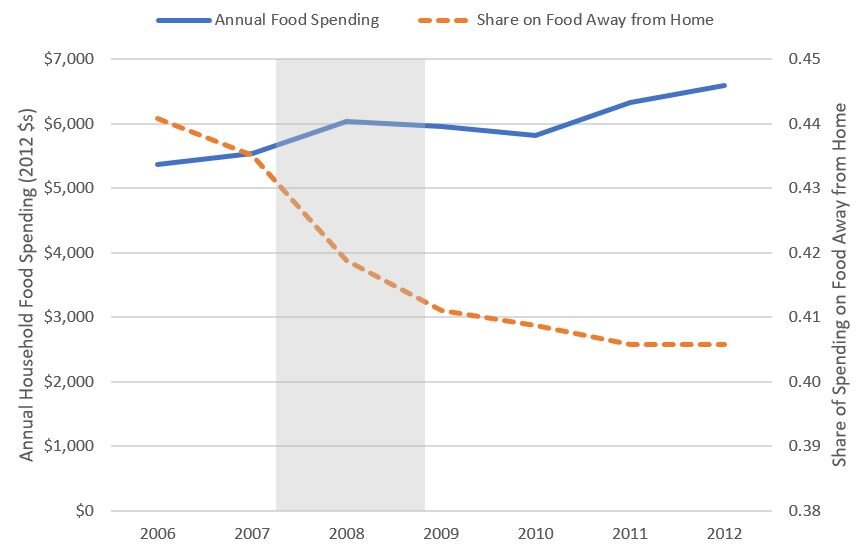The American Journal of Agricultural Economics just published a paper I co-authored with Sunjin Ahn, who is a post-doc at Mississippi State University entitled “Non‐Pecuniary Effects of Sugar‐Sweetened Beverage Policies.” (for the non-economists out there, “non-pecuniary” just means non-price).
Here was our motivation for the study:
“There is some market evidence that passage of SSB [sugar sweetened beverage] taxes might generate outcomes beyond that predicted by price elasticities (or the pecuniary effects). Non‐pecuniary effects could amplify the effects of a tax, increasing the intended effects of the policy. In particular, the tax (and the debate and publicity surrounding it) could send information to consumers about the relative healthfulness of beverage options and send cues as to which choices are “socially acceptable”
...
Signaling and information effects associated with SSB taxes are only one potential non‐pecuniary effect, and it is possible that some non‐pecuniary factors, such as reactance, could dampen the effects of a tax, and in the extreme could result in outcomes opposite that intended by the policy. ... Reactance is thought to arise from perceptions of threats to individual freedom, among other factors (Brehm 1966). Thus, although it seems clear that non‐pecuniary effects might exist, the size and the direction of the effect is ambiguous. ”
We tackled this issue by conducting a series of experiments through surveys with consumers. We asked consumers to participate in a series of simulated grocery shopping exercises. Consumers first made choices between beverage options at a given set of prices, and then they were randomly allocated to different treatments where either:
A) prices of SSB increased but respondents were not told why,
B) prices of SSB increased and respondents were told it was a result of a soda tax,
C) prices of SSB increased and respondents were told it was a result of a shortage of sugar beets and sugar cane,
D) the size of SSB was reduced but respondents were not told why,
E) the size of SSB was reduced and respondents were told the reduction was due to a government ban on large sized sugared sodas, or
F) the size of of SSB was reduced and respondents were told the reduction was due to a plastic shortage.
By comparing how choices of SSBs change when people were told prices or size changes were a result of a policy vs. other non-policy factors, we can get a sense of the size and direction of the non-pecuniary effects.
When conducted our first study in 2016, we found significant results related to the SSB taxes. In particular, our results suggested people who were told price changes were a result of a tax were more likely to choose SSB than people who were not given a reason for the price change. We certainly weren’t the first to find such an effect. Here is a bit about previous research on this topic:
“Just and Hanks (2015) argued that consumers might respond with resistance when a new policy obstructs their ability to obtain their preferred option. They argued that the phenomenon arises because consumers are emotionally attached to consumption goods, resulting in reactance. Policies perceived as paternalistic might cause consumers to “double down” on purchases of forbidden or restricted goods (Lusk, Marette, and Norwood 2013). Just and Hanks (2015) constructed a model in which controversial policies such as a sin tax could lead to an increase in the marginal utility for a good, potentially leading to increased consumption even if prices rise. In addition, Hanks et al. (2013) found that demand for unhealthy foods under a tax frame increased while the demand for subsidized healthy foods fell. Similarly, Muller et al. (2017) found that almost 40% of low‐income individuals increased their share of expenditures on unhealthy food after an unhealthy food tax.”
When we sent the paper off for review, we received a number of valuable comments, which caused us to make a number of changes to our experiment, and repeat the study with some extensions in 2019. What did we find with these newer data? On average: nothing, nada, zilch. There was no significant difference in the average market share of SSBs across the various information treatments. However, we did find significant variability in the treatment effects, meaning some people choose more SSBs when they knew it was a tax/ban and others chose less; however, these variations were only partly explained by demographic effects. In summary, our results didn’t provide a clear answer on the question we sought out to address: non-pecuniary effects, to the extent they exist, seem to work in different ways for different people, making the net effect small and hard to identify, at least in our experimental setting.
A note on the publication process is worthwhile. Normally, it is very hard to publish null results. This is problematic for the advancement of science because it results in publication biases like the file draw problem. To the credit of Tim Richards, the journal editor, and the three anonymous reviewers at the American Journal of Agricultural Economics, we received a positive reaction and ultimately, after a more changes, acceptance for publication even though we failed to replicate our previous result and found null effects. This is really an example of peer-review working at it’s best.













